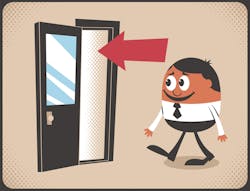Exit stage left: Using exit interviews to support practice management
Editor's note: For more articles like this, search for "Paul Edwards" in the search field above.
-----
Why did Hailey, the hygienist, quit so suddenly? What made our ace receptionist, Rob, take a job elsewhere? Is our ex-billing clerk, Brenda, angry at the practice for something another employee or doctor did...?
Providing an “exit interview” form to any employee who is terminated or who leaves your employment is an ideal way to learn the answer to these and other questions. Exit interviews also help you manage and/or lower your risks.
This is because an exit interview is a practice’s last useful chance to collect an employee’s perceptions of what your company was like to work for. If you find out in court, it’s too late! And while in some cases it may be obvious that a particular ex-employee will have nothing good to say, following through with each and every exit interview is more critical than you might think. Making a habit of them supports your own management actions and those of the practice as a whole.
Although exit interviews are important whether the end of employment came in the form of termination, layoff, or simply voluntary resignation, many misconceptions surround this topic. Some dentists and office managers seem to feel they must meet with a terminated employee in person like they do in the movies. This can easily turn into a disaster!
Remember, in the movies, the HR person is not directly connected to the situation, so it’s a lot easier for them to be impartial and remain in control. But in the average dental practice, the terminated employee is someone you’ve known and worked with – and possibly exchanged angry words with – recently. This seriously impacts the likelihood of either side feeling cool and collected during the exit interview.
Luckily, there is a way to make this entire process calmer, safer, and more effective. Here’s how making exit interviews a part of your normal routine can help protect the practice during the termination or end-of-employment process.
Exit interviews: How, when, and where
If your HR system can support it, you absolutely want the advantage of having asked ALL departing employees to fill out and return an exit interview form. The steps you should take depend on how the termination or resignation occurred, but in general your best practices are as follows.
If a termination or resignation occurs on-site:
· Place a copy of CEDR’s exit interview form in a self-addressed stamped envelope (SASE).
· Include it as you hand the employee their final paycheck (do NOT withhold this).
· Collect keys or company property if possible***.
· Let the employee know the business would appreciate it if they filled out and used the SASE to return the exit interview.
· Do not allow them to sit in the office and fill it out.
If a termination occurs via walk-out or job abandonment:
· Mail an exit interview form, an SASE, and a typed request that the ex-employee fill out and return at their convenience.
· Send with the final paycheck or separately, but do NOT send the exit interview before the ex-employee has been paid all wages due.
It’s best to send the request to fill out the exit interview letter by certified mail in the following instances:
· When an employee quits without reason;
· When an employee quits during a shouting match;
· If you suspect foul play of any kind; or
· If you suspect that a complaint (valid or not) may be lodged by the employee.
***Never withhold an employee’s final paycheck for any reason, with no exceptions. The final check should especially not be held to get the ex-employee to comply with a request (not even for return of company property). States have different rules and penalties for this, so if you have questions, please give us a call at 866-414-6056.
What About Angry Ex-Employees?
Obviously not every departing employee is going to report glowing feedback about your company, and some will be angry. But it’s still in your best interest to collect their feedback. When it comes to traumatic terminations, on more than one occasion I’ve helped doctors and their managers use the exit interview form to effectively end a dispute.
Here’s an example: Imagine an exit interview that is returned as three pages of pure ranting and reads like a manifesto. Do you think this written evidence would support a termination in which the employee was fired for not being able to accept constructive guidance, and not acknowledging their corrective action? It did.
And that isn’t all. The exit interview form serves a variety of useful purposes:
· It’s the employee’s “story” at the time of departure. If they file any future complaint containing a new or conflicting story, it can be a valuable written record for you, in the employee’s own words.
· It provides useful information to you as a manager and to the doctor/owner. Ex-employees who are no longer worried about keeping their jobs may inform you of problems.
· A departing employee may allude to improprieties or make direct accusations against the business or another employee. TAKE THIS VERY SERIOUSLY. At the very least you need to investigate and record your actions, as well as anything you did to address or correct any issues uncovered.
The Exit Interview Form is Evidence That You Tried
Even if you are not sure how an unhappy departing employee will respond to their exit interview, the fact that you took the time to ask speaks volumes for your “willingness and need to know.” This helps support the practice if any complaints should escalate.
And if the ex-employee fails to return the form, you’ll have the record that you tried – valuable evidence of fair and consistent management.
-----
Want a complimentary copy of our exit interview form? Dentistry IQ readers can download it for FREE from our website as part of our Employers’ Toolkit (http://www.cedrsolutions.com/dental-office-manual).
Have more questions? Email [email protected] or call CEDR’s HR experts anytime at 866-414-6056. We’re here to help!
Also by Paul Edwards: Terminations and layoffs: They're NOT tomatoes and tomahtoes | Are YOU a great boss?


